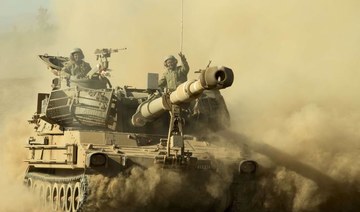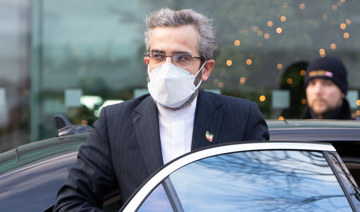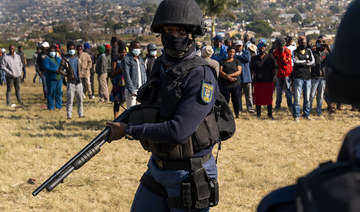JERUSALEM: Israeli Prime Minister Naftali Bennett held talks with the US national security adviser Wednesday, as Israel reaffirmed its opposition to negotiations on reviving a 2015 agreement on Iran’s nuclear program.
Jake Sullivan landed in Israel late Tuesday and met with President Isaac Herzog, who voiced “concern with Iran’s progress toward nuclear weapons under the cover of the negotiations in Vienna,” the president’s office said.
Israel has criticized talks in Vienna to restore the 2015 deal negotiated between Tehran and major powers that saw Iran agree to curbs on its nuclear activities in exchange for sanctions relief.
Israeli Prime Minister Naftali Bennett has called for the negotiations to be halted, accusing Iran of “nuclear blackmail” and charging that revenue it gained from sanctions relief would be used to acquire weapons to harm Israelis.
Ahead of Sullivan’s visit, a senior US administration official told reporters that Iran will “be very high on the agenda” for the Israel trip, during which Sullivan is also scheduled to meet Palestinian president Mahmud Abbas in the occupied West Bank.
Lead US Iran negotiator Rob Malley told CNN Tuesday that there are only “some weeks” left to revive the deal if Tehran continues its nuclear activities at the current pace.
Negotiations to restore the pact known as the Joint Collective Plan of Action resumed in November.
Washington was a party to the original agreement, but withdrew under president Donald Trump in 2018.
President Joe Biden’s administration has warned it may soon be too late to revive the JCPOA.
“It really depends on the pace of their nuclear process,” said Malley, the US special envoy for Iran.
“If they halt the nuclear advances, we have more time.
“If they continue at their current pace, we have some weeks left but not much more than that, at which point the conclusion will be there’s no deal to be revived,” he said.
Iran says it only wants to develop a civil nuclear program but Western powers say its stockpile of enriched uranium goes well beyond that, and could be used to develop a weapons capability.
Israeli PM meets US national security adviser on Iran
https://arab.news/ywqek
Israeli PM meets US national security adviser on Iran

- Iran says it only wants to develop a civil nuclear program but Western powers say its stockpile of enriched uranium goes well beyond that
Cyclone kills 16 in India, Bangladesh and cuts power to millions

- Cyclone Remal is first of frequent storms expected to pound low-lying coasts of South Asian neighbors this year
- More than 8.4 million people, including 3.2 million children, at high health, nutrition, sanitation, safety risk
SATKHIRA, Bangladesh: Strong gales and heavy rain triggered by the first major cyclone of the year lashed the coastlines of India and Bangladesh on Monday, killing at least 16 people and cutting power to millions.
The winds had not stopped as night fell, with water rising in many places and overwhelming drainage systems, Bangladeshi climate expert Liakath Ali said.
“Many people are stranded — it will be another long night ahead with millions not having electricity or shelter,” he said in a statement. “And people having no idea of how damaged their homes, land and livestock are.”
Cyclone Remal is the first of the frequent storms expected to pound the low-lying coasts of the South Asian neighbors this year as climate change drives up surface temperatures at sea.
Packing speeds of up to 135 kph, it crossed the area around Bangladesh’s southern port of Mongla and the adjoining Sagar Islands in India’s West Bengal late on Sunday, weather officials said, making landfall at about 9 p.m.
More than 8.4 million people, including 3.2 million children, are at high health, nutrition, sanitation and safety risk, said Sheldon Yett, UNICEF Representative to Bangladesh.
At least 10 people were killed in Bangladesh, disaster management chief Mijanur Rahman told Reuters, adding some victims died en route to shelters or when their homes or walls collapsed, or drowned during the storm.
“People are usually very reluctant to leave their livestock and homes to go to cyclone shelters,” he said. “They wait until the last minute when it is often too late.”
State Minister for Disaster Management and Relief Mohibbur Rahman said the cyclone destroyed nearly 35,000 homes across 19 districts. An additional 115,000 homes were partially damaged.
“Many areas remain waterlogged, and fish enclosures and trees have been devastated. As more information becomes available, the full scope of the impact will be clearer.”
MANGROVE FORESTS FLOODED
In India’s West Bengal state, four people were electrocuted, authorities said, taking the death toll in the state to six.
Bangladesh shut down electricity supply to some areas in advance to avoid accidents, while in many coastal towns fallen trees and snapped electricity lines further disrupted supply, power ministry officials said.
Nearly 3 million people in Bangladesh were without electricity, officials added. West Bengal authorities said at least 1,200 power poles were uprooted, while 300 mud huts had been razed.
Bangladeshi State Minister for Power and Energy Nasrul Hamid said in a Facebook post that Remal has caused extensive damage nationwide, urging people to be patient as repairs were under way.
“Our crews began repairing the lines as soon as the wind speed subsided,” he said.
The cyclone also disrupted around 10,000 telecom towers, leaving millions without mobile service.
The rain and high tides damaged some embankments and flooded coastal areas in the Sundarbans, home to some of the world’s largest mangrove forests, which are shared by India and Bangladesh.
Flooded roads disrupted travel in the Bangladeshi capital of Dhaka. Rain also flooded many streets in the Indian city of Kolkata, with reports of wall collapses and at least 52 fallen trees.
Kolkata resumed flights after more than 50 were canceled from Sunday. Suburban train services were also restored.
Both nations moved nearly a million people to storm shelters, about 800,000 in Bangladesh and roughly 110,000 in India, authorities said.
Zuma’s party guns for ANC stronghold in South Africa vote

- The emergence of uMkhonto we Sizwe, has increased tension in Kwazulu-Natal, a key election battleground already infamous for political violence
KWAXIMBA, South Africa: In a village nestled in the mountains of South Africa’s hotly-contested Kwazulu-Natal province, former President Jacob Zuma’s new party has campaigned relentlessly to win voters away from his old one, the ruling ANC.
On Monday, rival tents pitched by the two parties outside a local school serving as a polling station blasted party songs welcoming early voters they hoped to sway.
Most South Africans will vote on Wednesday but some, including the elderly and the infirm, were allowed to cast their ballots on Monday in what is expected to be the tightest election in decades.
The emergence of Zuma’s uMkhonto we Sizwe (MK), has increased tension in Kwazulu-Natal, a key election battleground already infamous for political violence.
KwaXimba, a rural area dotted by thatched “rondavel” huts outside the eastern city of Durban, has been ruled by the African National Congress (ANC) since the dawn of democracy in 1994.
But many here revere Zuma, an ethnic Zulu, who was born in the province.
“We’ve needed change for a long time in our lives,” said Thokozani Mthembu, the MK’s local coordinator in KwaXimba.
Some opinion polls suggest that MK could win the most votes in Kwazulu-Natal. This would almost certainly condemn the ANC to its worst electoral result in three decades.
It could lose its parliamentary majority for the first time and be forced to form a coalition government.
Voting proceeded smoothly in KwaXimba during the day, but in a tense atmosphere.
Mthembu claims that after Zuma, 82, held a rally with hundreds of supporters in KwaXimba in January, the party received threats of violence from ANC supporters. Some voters were also wrongly told that the MK would take away social grants and free housing, he said.
The ANC denies all wrongdoing.
“From the day we started our campaign, we’ve had one goal, which is to win the election without threatening other parties,” Sihle Gwala, a local ANC leader, told AFP.
Earlier this month, police warned against “spreading statements that have a potential of inciting violence or create a state of panic in the communities” after a voice note circulated claiming that 11 people were killed in a politically-related shooting.
Many in KwaXimba have turned to the MK, lamenting continuous water and electricity shortages, which some blame on the ANC’s poor management.
Down the road from the school, chickens clucked in 66-year-old Nicolas Ndlovu’s yard, as he walked outside, waiting for election officials to reach his home and allow him to cast his early ballot.
Having fought for the ANC during the anti-apartheid struggle and supported the party all his life, he said he now hoped to see it end up in opposition, so that “maybe they can work harder and earn the power back.”
His village’s streets, where cows roam under the sun, are plastered by campaign posters of the rival parties.
ANC volunteer Jabulile Nduna said the rift between Zuma and her party has caused divisions within her own family.
“I sat (down) my siblings and told them, ‘at the end of the day we have one mother and one father’... whether the MK wins or the ANC wins, we have to remain a family,” said the 43-year-old mother of three, as she walked on a gravel road near a voting station.
During a campaign visit to KwaXimba last month, President Cyril Ramaphosa warned voters about new parties trying to “nibble the edges” of ANC support, saying they would fail to win power.
But some like Nkazimula Makhanya are not heeding the call.
At 26 he has no job and few prospects of getting one, with youth unemployment at 45 percent.
“The old man, as old as he is, he still values our input, and he still allows us to be winners,” he said, referring to Zuma.
Parts of Bangladesh and India affected as storm floods villages, cuts power to millions

- About 3.7 million people along Bangladesh’s coast were affected, disaster ministry says
- Bangladesh, a delta nation of nearly 170 million people, has a history of violent storms
DHAKA, Bangladesh: The weakening tropical storm Remal flooded dozens of coastal villages and left nearly 30 million people without power Monday in southern Bangladesh and eastern India. At least 10 people died in Bangladesh.
About 3.7 million people along the coast were affected, said Bangladesh’s junior minister for disaster management and relief, Mohibbur Rahman. More than 35,000 homes were destroyed and nearly 115,000 were damaged. Nearly 800,000 people were evacuated from vulnerable areas on Sunday.
Bangladesh, a delta nation of nearly 170 million people, has a history of violent storms. Disaster preparedness programs have upgraded the capacity to tackle natural disasters, resulting in fewer casualties. Changing climate patterns have increased storms’ intensity, making preparations more urgent.
Remal weakened after making landfall in Bangladesh’s Patuakhali district early Monday, with sustained winds of 111 kilometers (69 miles) per hour. India’s Meteorological Department said it was likely to weaken throughout the day, but warned of heavy showers over Assam and other northeastern states for the next two days.
India’s Kolkata airport reopened after being shut Sunday. Bangladesh shut the airport in the country’s second largest city, Chattogram, and canceled all domestic flights to and from the coastal district of Cox’s Bazar. Loading and unloading at Chittagong seaport was halted.
Strong rain and winds battered the Bangladesh capital, Dhaka. Many roads were submerged. Authorities ordered all government officials to stay at their stations until the situation improved.
Aid agencies said they deployed thousands of volunteers in Rohingya refugee camps and other affected areas to provide emergency support. Bangladesh has sprawling camps housing more than 1 million Rohingya refugees from Myanmar in Cox’s Bazar.
In India’s West Bengal state, thatched roofs on houses were blown away and electric poles and trees were uprooted in some coastal districts. Heavy downpours inundated streets and homes in low-lying areas of Kolkata. All schools in the region were closed until further notice.
For deaf children in Pakistan, school is life

- Of more than a million deaf school-age children in Pakistan, less than five percent go to school
- According to World Federation of the Deaf, 80 percent of world’s 70 million deaf people have no access to education
LAHORE: At a school for the deaf in Pakistan, the faces of students are animated, their smiles mischievous, as their hands twirl in tandem with their sign language teacher.
The quiet classes exude joy, led often by teachers who are also deaf.
“I have friends, I communicate with them, joke with them, we share our stories with each other about what we have done and not done, we support each other,” said Qurat-ul-Ain, an 18-year-old deaf woman who joined the school a year ago.
More than 200 pupils, children and adults mostly from disadvantaged backgrounds, are among the few given a new fervor for life at this inner-city school in historic Lahore.
Of more than a million deaf school-age children in Pakistan, less than five percent go to school.
The figure is even lower for girls and, without a language to express themselves, many children are marginalized by society and even their families.
“Life is a little difficult. There is a huge communication gap here where people generally don’t know sign language,” said Qurat-ul-Ain.
At the school run by charity Deaf Reach, pupils learn sign language in English and Urdu before progressing on to the national curriculum.
Everyone has a name in sign language, which often has to do with a physical characteristic.
Younger children learn with visuals: a word and a sign are associated with an image.
Their peers turn their thumbs down for a wrong answer and make the applause sign — twisting hands — for a correct one.
Founded in 1998 by an American and funded with donations, Deaf Reach now has eight schools across the country, educating 2,000 students on a “pay what you can afford” basis, with 98 percent of children on scholarships.
The vast majority of students at the school come from hearing families, who are also offered the chance to learn how to sign and break the language barrier with their son or daughter.
Adeela Ejaz explained how she struggled to come to terms with her first born son — now 10 years old — being deaf.
“When I couldn’t understand what he was trying to say he would bang his head against the wall and floor,” the 35-year-old told AFP.
“It was tough for everyone because no-one knew how to communicate with him. Everyone would tell us he is deaf but I wasn’t prepared to accept that.”
The mother and son pair are now both learning to sign.
“I am getting better at signing and I am able to communicate with my son. He’s now become so attached to me.”
“ATTITUDES IMPROVING”
The program makes extensive use of technology, and offers an online dictionary and a phone app.
It has also found employment for more than 2,000 deaf people with around 50 Pakistani companies.
Huzaifa, 26, who became deaf after contracting a fever at a young age, was given a stitching apprenticeship at Deaf Reach to help him into the skilled workforce.
“Teachers in the government school didn’t know any sign language. They would just write notes on the board and tell us to copy it. We used to get really disheartened, and I would be extremely worried for my future,” he told AFP.
His family pushed for him to become educated, helping him to learn the basics of sign language before he received formal coaching.
“My parents never threw me away. They spared no effort in ensuring I was able to continue my education,” he said.
Without their dedication, he said: “I’d be working as a day laborer somewhere, cutting leaves or cementing walls.”
Sign language varies from one country to another, with its own associated culture, and regional variations sometimes exist.
According to World Federation of the Deaf, 80 percent of the approximately 70 million deaf people in the world have no access to education.
“I used to sit idly at home, use the mobile or play outside. I never had a clue about what people were saying,” said Faizan, 21, who has been at Deaf Reach for 11 years and dreams of working abroad.
“Before learning how to sign I used to feel very weak mentally and had an inferiority complex and fear. But thankfully there is none of that anymore.”
Attitudes toward people with disabilities are slowly improving in Pakistan, which has introduced laws against discrimination.
“We have seen over the years the mentality change tremendously. From many people hiding their deaf children, feeling embarrassed, ashamed,” noted Daniel Marc Lanthier, director of operations of the foundation behind Deaf Reach.
Nowadays families are “coming out in the open, asking for education for their children, asking to find employment for them,” he said, though much work remains.
“With a million deaf children who don’t have access to school, it’s a huge challenge, it’s a huge goal to be met.”
‘Unlikely’ to be more survivors from Papua New Guinea landslide

- Some 2,000 people are feared buried by a massive landslide that entombed a remote highland community
- Full-scale rescue and relief efforts have been severely hampered by the remote location
PORT MORESBY: It is “very unlikely” more survivors of Papua New Guinea’s deadly landslide will be found, a UN agency warned Tuesday, as thousands at risk from further slips were ordered to evacuate.
Some 2,000 people are feared buried by a massive landslide that entombed a remote highland community in the early hours of May 24.
Since then, locals have been picking through a hellscape of meters-deep churned-up earth, uprooted trees and car-sized boulders in the search for loved ones — often using little more than their hands, shovels and digging sticks.
But hopes are dimming that anyone is alive underneath the mountain of rubble.
“It is not a rescue mission, it is a recovery mission,” UNICEF Papua New Guinea’s Niels Kraaier said. “It is very unlikely they will have survived.”
Full-scale rescue and relief efforts have been severely hampered by the remote location, the only road link being severed, heavy rainfall and nearby tribal violence.
The Papua New Guinea Defense Forces have struggled to access the site with heavy earth-moving equipment.
Early on Tuesday, Enga provincial administrator Sandis Tsaka warned the disaster could worsen further, as clumps of limestone, dirt and rock continue to shear off the side of Mount Mungalo.
Tsaka said authorities were now trying to coordinate the evacuation of almost 7,900 more people.
“The tragedy is still active,” he said. “Every hour you can hear rock breaking — it is like a bomb or gunshot and the rocks keep falling down.”
Aid officials said many residents were refusing to leave at-risk areas because they were holding out hope of finding loved ones.
Satellite images show the enormous scale of the disaster.
A vast smear of yellow and grey debris can be seen cutting through once verdant bushland and severing the region’s only road.
“This was an area heavily populated with homes, businesses, churches and schools, it has been completely wiped out. It is the surface of the moon — it is just rocks,” said Tsaka.
“People are digging with their hands and fingers,” he said, expressing anguish at the unde-resourced government’s inability to meet the enormity of the disaster.
“I am not equipped to deal with this tragedy,” Tsaka admitted.
Overwhelmed Papua New Guinea authorities held an online emergency meeting with United Nations agencies and international allies Tuesday, hoping to kickstart the relief effort.
Papua New Guinea’s national disaster center has told the United Nations that the initial “landslide buried more than 2,000 people alive.”
According to a letter obtained by AFP, the slide also “caused major destruction to buildings, food gardens and caused major impact on the economic lifeline of the country.”
The scale of the catastrophe required “immediate and collaborative actions from all players,” it added, including the army, and national and provincial responders.
Australia has announced millions of dollars worth of aid, including emergency relief supplies such as shelters, hygiene kits and support for women and children.
China’s President Xi Jinping and his US counterpart Joe Biden — more accustomed to scrapping for influence in the strategically located country — both offered assistance.
More than 1,000 people have already been displaced by the catastrophe, aid agencies have estimated.
UN Development Programme official Nicholas Booth said up to 30,000 people could have been cut off by the disaster across several villages.
These communities had enough supplies for the coming weeks, but opening up that road remained essential, he said.
“This landslide has blocked the road westward, so not only are there challenges in accessing the village itself, but it does mean the communities beyond that are also cut off.”
Locals said the landslip may have been triggered by recent heavy rains.
Papua New Guinea has one of the wettest climates in the world, and research has found shifting rainfall patterns linked to climate change could exacerbate the risk of landslides.
The estimated death toll has climbed significantly since the disaster struck, as officials reassess the size of the population.
Many people fleeing tribal violence have moved into the area in the past few years.
The area is located about 600 kilometers from Port Moresby.


















